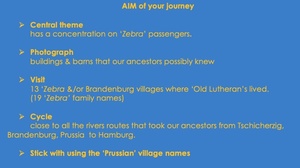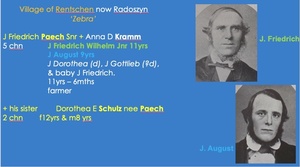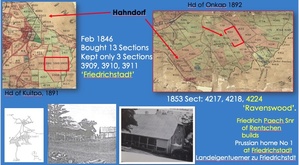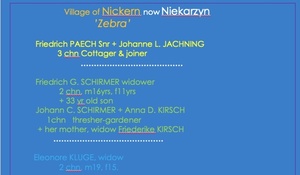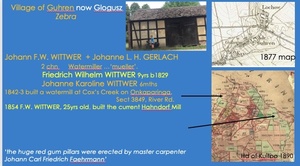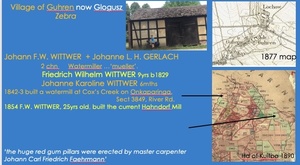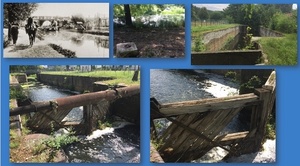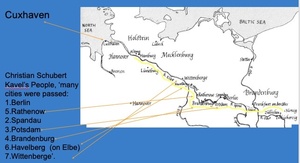This Page forms part of the overall Zebra-ProjectBy clicking on the following Link a list of all Zebra-Project tabbed pages will be displayed. |
Journey with the Oder Barges, 1838: Friedrich Wilhelm Kanal to Hamburg
To return to: Lothar BRASSE summary
ADVERTISING. Second presentation to the SAGHS German group, 11 December 2019.Join the passengers on the Prince George, the Bengalee & the Zebra as they leave the Friedrich Wilhelm Canal, pass through Berlin, onto the Havel, & through to Havelberg where the river flows into the Elbe, for their journey to Hamburg.
This is Part 2 of ‘Cycling in Kavel's Country’, by J Haynes.
Thank you…….I am going to be drawing on the earliest stories that came on these ships to S.A. ……..& I will be focusing on the passengers from the Zebra but drawing on some relationships & research from the other 3 ships. My presentation will include information from
Capt Hahn, Wittwer, Reg Butler, Lothar Brasse, I Iwan, David Schubert f you have any questions could you leave them until the end. You are going on a journey to see the rivers they traveled on, visit their villages & lands they walked on & came from.Gallasch of Grünthal reference
3. These maps might look familiar … they come from excellent family history books written in the 80’s, & this example on the left, from David Schubert describes their journey as: ‘The emigrants had to travel to the port of Hamburg from their inland villages by barge along rivers, …..These barges were commonly called Oder barges. The journey was along four different rivers (Oder, Spree, Havel and Elbe) and on the Friedrich-Wilhelm-Canal that connected the Oder and the Spree rivers, was about 600 km long and took three weeks.” Altona is identified as being to the north and Cuxhaven is shown at the mouth of the Elbe.
Questions I had:
Where actually did my ancestor live?
What propelled the barges all that distance?
How did this river system work?
Could I find the Friedrich Wilhelm Canal?
4.
5.
6.From Schwiebus to Züllichau is 20kms, that is the same distance as from Goolwa to Victor Harbour. Within the blue square are most of the ‘Zebra’ villages you will be visiting. Large paddocks, big machinery, extreme hot weather event in Europe, 2018. The area called the Province of Brandenburg, Prussia, is now the province of Lubuskie, Poland Prince George & Bengalee people came from East of Züllichau, Brandenburg. Zebra people came from the West, NW of Züllichau, Brandenburg. Catharina people came from NE of Züllichau, Posen. The next section of this presentation will be you cycling from Schwiebus, to
Rentschen, to Nickern, Schönborn, to Kay, up to Rissen, down to Zullichau & out to Klemzig. Now you begin by leaving Schwiebus & cycling south…. first stop is to visit the Paech’s in Rentschen.
POINT OUT THE ROUTE Next time you see this map it will be only the area within the blue square
7.
Is anyone here directly related to these two sons?I will call this family the ‘Rentschen Paech’s’ & the following photos & information is courtesy of the Paech Family History 1800-1972, written in 1972 by Walter H Paech of Camberwell VIC pge 10 describes ‘Johann Friedrich Snr as an elder in the Lutheran congregation in Rentschen, & also that it was his 5 yrold daughter, Johanna Dorothea who died at sea on the Zebra.
Capt Hahn described this story : ‘Elder Paech declared that the doctor had given him two powders, one of which he had given his daughter, & she immediately had colic and died 2 hours later. The second powder he kept to have analysed in Australia’. Walter Paech also suggests that it is possible Friedrich & Anna’s 3rd son, 3 year old Johann Gottlieb may also have died on the Zebra. Friedrich & his wife Anna were on the Zebra with their 5 children, as well as his sister and her family I will track Friedrich and his two sons Friedrich Jnr & August, 11 & 9 in 1838. According to Allen’s Almanac of SA within five years (1843) Friedrich Snr from Rentschen was productively farming at Grünthal on 40 acres & at some stage after this he purchased 80 acres at Grünthal, now known as Verdun.
8.
Three years later, in Feb 1846 while living at Grünthal (A Wittwer) J Friedrich Paech of Renteschen purchased 13 sections of land / 1175 acres for 1,300 pound. 10 sections were sold to other Prussians via Pastor Kavel & I will tell you more abut those families soon. His older sons Friedrich & August were now 20 & 18yrs old. J Friedrich Snr kept 3 sections for his family, 3909, 3910, 3911 containing 240 acres & this locality was named ‘Friedrichstadt.’ Alan Wittwer said that Friedrichstadt, in the Hundred of Kuitpo, ‘stretches from the Hahndorf Cemetery in the north to the boundary of the Mt Barker & Meadows district councils in the south and from Biggs Flat in the west to Paechtown in the east.
‘On the land at Friedrichstadt J Friedrich from Rentschen erected a 2 story house in the old Brandenburg architectural style. It had a high, steeply pitched roof of woodenhingles, now covered with roofing iron. Heavy wooden beams, supported by strong trusses, and two flights of stairs are features of the interior of the house.’Friedrich remained very active in the Lutheran Church & lived & died in this home 1870.
J Friedrich Jnr had been married for 2 years & August was about to be married in 1853 when their father purchased more land in the Hd of Onkaparinga, Section 4217 & 4218, 160 acres, A bit later that year Friedrich Senior also purchased the small section 4224 where a new home was built, known as ‘Ravenswood’, sometime after 1853.My understanding is that Friedrich Paech Jnr, the eldest son lived on this land & eventually inherited it in 1871 after his fathers death at Friedrichstad….. I want to take a moment follow this eldest son Friedrich JnrThe house on the bottom left from Iwan’s book had been wrongly identified & is now positively identified as the home of Friedrich Paech snr. of Rentschen.So two photos of the same house.
9
In 1851, at 25yrs old he married a J Louise Paech & had 13 children over the next 21 yrsbetween1852-73, he died in 1887 aged 61yrs. Friedrich Jnr & his wife celebrated several of their children’s marriages at Ravenswood from 1882 onwards. Section 4224 was purchased in 1853, so sometime between that 1853 and 1882 ‘Ravenswood’ musthave been built, & I am calling it here the Prussian home No2. I want to follow his brother now…
10August married in 1853 at 25 yrs to Maria Paech (a sister to his brothers wife) & had 10 children over 16yrs between 1854-1870 & died suddenly by accident, 1872. Leaving his youngest child only 2 yrs old.August had this house … 300 yards from ‘Friedrichstadt’ ….I am not sure if it is on section 3909, 3910 or 3911 of KuitpoI would welcome more accurate information during question time if you have it. His house is another example of fachwerk, using no nails in its construction, I call it Prussian fachwerk house no 3.Reg Butler in 1982 gives a very interesting and detailed picture of how it was that Frederick Paech Snr from Rentschencame to acquire the land known as Friedrichstadt, including the withdrawal of credit to SA by the British Government and how this impacted on land sales around Hahndorf. Pge 37 of ‘George Hartmann of the Prince George’ a family history.
11 Paechs also came on the Zebra from the village of Nickern.I will call this family the Paech’s from Nickern & along with them came the widower Schirmer & his children, plus his 33 yr old adult son
& his daughter in law nee Kirsch & their child & the wife’s widowed mother.& another widow Eleonore Kluge with her 2 children.
12 Captain Hahn quoted on Page 69 of Paech FH red book. 0 chn 10 & over31 chn over 626 chn over 3 mths4 infants
13. awing by Lothar BrassePhotos courtesy Reg Butler’s George Harmann of the Prince George Reg Butler names the second son, ‘Christian Paech as the instigator of the scheme to acquire a goodly tract of land to settle his father, brothers & himself. He would have been 32yrs old in 1853 when this Paechtown subdivision was completed.Christian married Mariane Wallent, they had 3 children, Christian died in 1905 and the property was passed to his youngest son August Paech who married Wilhelmina Wiese, & there 6th child was Herman Christian Paech who married Alexandra Bates and there son was Grant Paech of Beerenberg. Gottlob the 3rd son….George Paech Jnr the 4th son married Johanna Hartmann who was 10 years old when on the Prince George with her family, they went to live in Paechtown soon after their marriage in January 1850 & family members have said that there first child was born their in November 1850……. Lothar Brasse writes: 4 farmhouses were built on this section 3917, & adjacent several half framed barns.…it is probable that the buildings began in the mid 1850’s… the timber frames to boththe houses and barns are magnificent examples of the carpenter’s art. Also significant is theuse of brick infill panels on the more important and what seem to be the later built houses.
Lothar Brassee house no 3, Hahndorf Survey 1, pge 185
PAECHTOWN HOUSE NO 3
In 1897 Hans Heysen, painted house no 3 & called it ‘At Friedrichstadt, near Hahndorf’
LOTHAR BRASSE, ARCHITECT ESSAY
“This South Australian pioneer German house represents the best of SA
Germannes with its steep half-hipped roof, fachwerk construction”. Lothar Brasse‘I believe these buildings are of international importance because they represent the best collection of its genre - not just within Australia but also outside Europe. I believe that Carl Fährmann was one of many carpenters in the Australian context that built these half timbered (Fachwerk) structures - but, Carls’ were without doubt the most substantive and artistic’. Lothar BrasseLothar continues,.
‘Gladigau was also a carpenter who was active in & around Hahndorf, his brother, also a carpenter (Zimmerman) joined them later and I believe that the Gladigaus’ built a different style of 'Fachwerk' than Carl in and around Hahndorf. I think I have drawn and measured every 'Fachwerk' building in Australia.’
WILL COME BACK TO GRANT PAECH
Berenberg Book Pge 3
Wiki tree says 3 were: J Wilhelm August P, Louise Roder, J August.
14 West of Kay was the village of Guhren, it appears on this 1877 map to be along the road between Kay & Lochow in the area where this Fachwerk barn was facing the road.
Four years after leaving his watermill in Prussia Friedrich Wittwer purchased Section 3849& built his own watermill at the junction of Cox's Creek and the Onkaparinga River.
In July 1853 he received a Land Grant of 81 acres, for 81 pounds sterling, the title for Section 4232.The huge red gum pillars were erected by master carpenter, Johann Carl Friedrich Faehrmann.
………………………
In March 1906 he sold this land to J August Paech, the son of the Kaysher George Paech the 4th son, who had also inherited the Paechtown house no 2.
15.
Pge 20 Reg Butler JEANSCH, OR SCHUBERT OR KAVEL.“Before reaching Frankfurt, we took a left hand turn into the Friedrich Wilhelm Canal, a navigable eight-mile channel built by Friedrich Wilhelm 11 (the Great Elector) of Prussia, to link the Oder and the Spree.”
16
“On the way we encountered some difficulties . The water in the canal was very low in some places”G Hartmann pge 20
Pge 20 Reg Butler “and at times, it became necessary for as many who could do so to help to tow the ships along with two ropes down the stream.”
Pge 20 Reg Butler “When we reached the locks, it was a wonderful sight to see. It was as though the ship was going up a mountain of water, and
then would sail down into the fairway.”
Sluice Janitor
Schleusenmeisterhaus
In the 14th century there were plans to join two rivers the Oder and the Spree in order to develop east-west trade. It was in the 17th C when the canal, as one of the first in Germany was brought into life by Frederic William, Elector of Brandenburg. It took seven years of construction to build the 14 sluices and 8 bridges and was opened in 1668. It shortened the trip from Silesia to Hamburg and was safer than the land roads.
Renovation & reconstruction works in 1869 were commemorated with this monument “To commemorate the 200thanniversary of the Frederic-William Canal opening”.
18
The last two weeks of WW2 the town experienced catastrophic damages, including to the sluices & bridges, blown up by the retreating German army, and his can be seen in the large pond on the top left.
The Friedric-Wilhelm Canal on the left & the Spree Kanal joining together, the Oder Spree Canal was built in 1908 & took our
ancestors through Berlin.The River Spree is a tributary of the River Havel .The Havel flows into the Elbe river and then into the North Sea, from Hamburg.
The Spree runs through Berlin turns into the Havel 12kms to the west of Berlin near Spandau.
19.
This map is from Kavel’s People pge 8, & it shows where the Oder barges turned north towards Hamburg.The list given is not in the right order…. but it clearly indicates that our ancestors kept to the River Havel
which is a tributary of the Elbe, until it reached the Elbe at Havelberg.
20
Christian Schubert, from the Prince George has his story recounted in pge 15 of Kavels People …….‘In high spirits we travelled through the towns of Prussia, into the canal
System of the Spree, Havel & Elbe, reaching Hamburg in 3 weeks….This is the journey we are now going to follow……& this building from 1720 was one that they would have passed by.
21
Oder-Spree KanalSurrounded by large forests.



